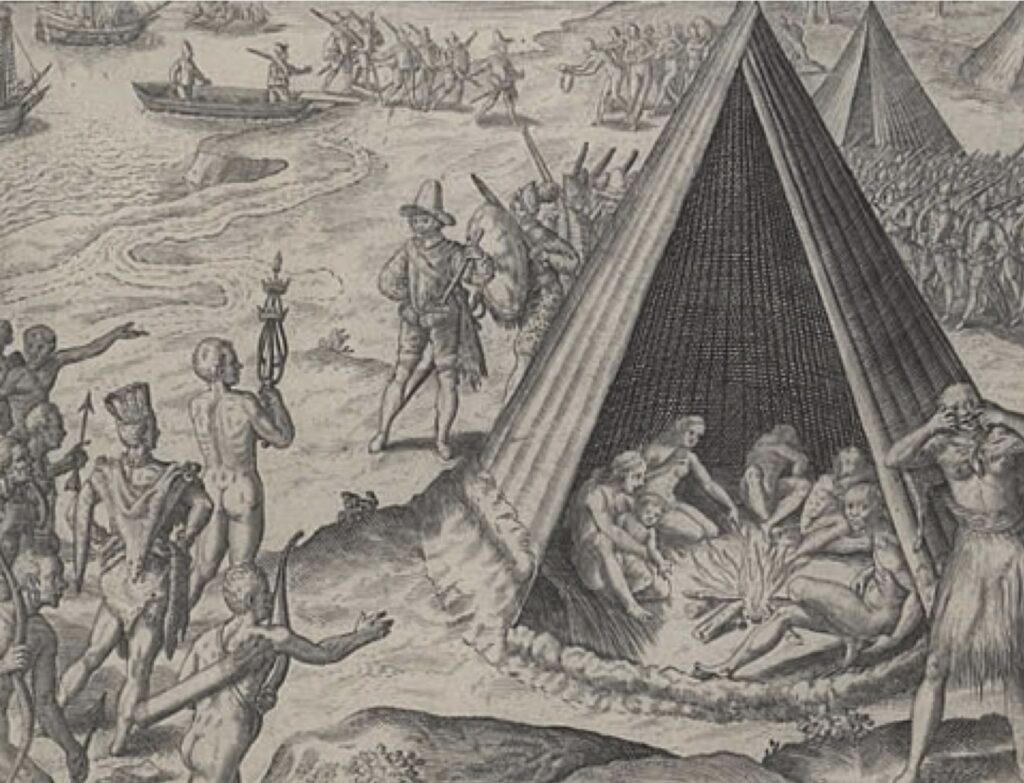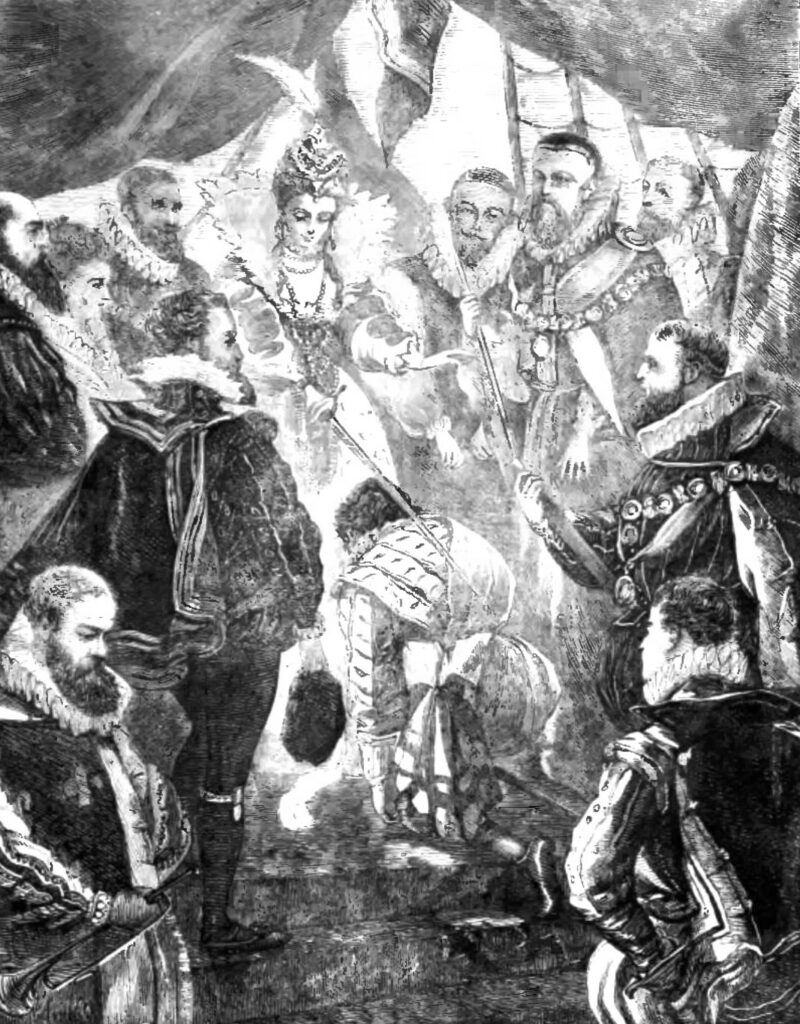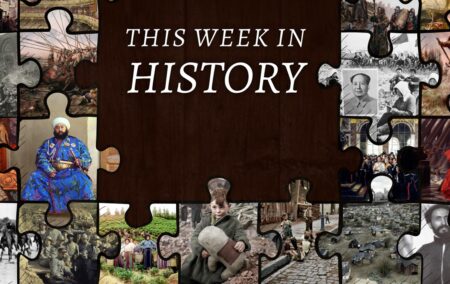This Week in History recalls memorable and decisive events and personalities of the past.
4th April 1581 – Francis Drake is knighted by Queen Elizabeth I for completing a circumnavigation of the world.
At the beginning of the 1500s, the Spanish and Portuguese had exploded onto the world stage establishing the first trans-Oceanic empires in world history.
With their mastery of navigation and ship building, the captains of these two nations carried traders, missionaries and troops across the world, such that by the 1570s the Portuguese had outposts stretching from China, to India, to Africa, to Brazil and Spain ruled an empire which stretched from Mexico to Chile.
Under the guidance of the Pope the Portuguese and Spanish had even signed a treaty, The Treaty of Tordesillas, which you can read about here, dividing the world between the two powers. (https://dailyfriend.co.za/2020/06/12/29919/)
Both nations were fairly poor at the start of the 1500s, especially Portugal, however these new trade networks, and the massive quantities of silver the Spanish found in South America, saw the two kingdoms rise in prominence and wealth throughout the 1500s.
Their rapid expansion was built on shaky foundations however, as the Spanish in particular fought endless wars in Europe to preserve their territories in the low countries and against the Ottomans in the Mediterranean, and did relatively little to develop their economy, eventually resulting in massive monetary inflation. This saw the mighty Spanish empire become overstretched and weakened as the 1500s progressed.
The success of the Iberian Empires would attract many jealous eyes. The English, newly Protestant and seeking a place to expend their energy now that they had been ejected from France, and the Dutch, who had fought Spain for independence, sought to plunder these wealthy global empires.
As part of these efforts to raid and undermine the Spanish and the Portuguese, the English and Dutch authorised piracy against their valuable treasure ships carrying goods and silver returning from their colonies.
In 1572, one such English pirate, Francis Drake, led his first raid of Spanish America. The raid was very successful with 14 Spanish ships surprised and plundered; as well as 6 port towns being raided. During the journey Drake and one of his lieutenants, whilst exploring the mountains on the Isthmus of Panama, climbed a tree and became the first Englishmen to see the Pacific Ocean.

Sir Francis Drake Anglo-Dutch School.jpg – Wikimedia Commons
This expedition, which ended in 1573, established Drake as a competent captain and leader, and he would seek to repeat it in the following years.
On his return to England, Drake would fight on behalf of the English in Ireland against Spanish-backed rebels.
In 1577, Queen Elizabeth the First secretly commissioned Drake to lead a new global raid against Spanish and Portuguese ships. He was given 1000 crowns for this mission. A further goal of the expedition was to scout for potential English trading settlement locations.
On the 13th of December 1577, Drake set out from Plymouth with 3 ships and 2 supply vessels, led by his flagship the Pelican (later renamed the Golden Hind). In January 1578 Drake’s ships arrived in the Portuguese controlled Cape Verde Islands and attacked a Spanish ship, which they captured. The ship had a skilled Portuguese navigator on board, who the English recruited, and was filled with wine and supplies.
In May 1578 Drake anchored off of the coast of Brazil after a number of storms had ravaged his fleet. Drama was brewing in the fleet since the capture of the Spanish ship in Cape Verde. Drake had increasingly feuded with one of his commanders, a man named Doughty. Doughty had been effectively second-in-command, controlling the second most important ship in the expedition, but had accused Drake’s brother of stealing the captured wine. Doughty was demoted to command of one of the smaller ships.
After the bad luck which had resulted from the storms, Drake became convinced that Doughty was practicing witchcraft to destroy the expedition. Drake had Doughty arrested along with his brother in June 1578, and in July Doughty was found guilty of plotting a mutiny and was beheaded.
In late July 1578 the expedition reached the straits of Magellan at the southern end of South America. Soon after, massive storms destroyed one of the ships which was lost with all hands. Another one of the ships turned around soon after and sailed back to England.
By the time Drake exited the straits he had only his flagship left with just half of the crew left alive. During their time rounding South America, the expedition fought with and traded with many local peoples, notably the Mapuche people. During a fight with the Mapuche 2 sailors were captured and one of Drake’s friends and servants, a man named Diego, was badly wounded. He would later die from his wounds. According to the English the captured sailors were eaten alive by the Mapuche in a religious rite.
Upon making it to the western coast of South America, Drake raided several Spanish towns on the coast of modern day Chile and Peru.
During these raids Drake captured the Spanish treasure ship the Nuestra Señora de la Concepción, which had left Peru bound for Panama, and sailed it onto the Philippines. The ship contained 26 tons of silver and other valuables equaling around £480 million in today’s money.
Drake sailed north, looking for a passage back to England, as it was believed at the time there was a strait connecting the Pacific and Atlantic that was ice free. His ships went as far north as the U.S. state of Oregon.
He later turned south again and landed in Northen California, which he named New Albion. The site at which he landed is close to the modern city of San Francisco.

By MikeVdP – Own work, CC BY-SA 4.0, https://commons.wikimedia.org/w/index.php?curid=92312516
Drake decided to set off for home across the Pacific Ocean, with good winds to carry him across fairly quickly. He arrived in the Moluccas, modern day Indonesia, at the time when the Portuguese had been driven, mostly, out of their settlements in the area by local attackers.
Drake met with the a sultan of the island of Ternate called Sultan Babullah. Babullah was an enemy of the Portuguese, and fed Drake and his men the first proper meal they had in months. They ate rice, chicken, sugarcane, liquid sugar, fruit, coconuts and sago. Drake was invited to join expeditions against the Portuguese in the area, but declined, seeking to get home to England.
Drake traded linen, silver and gold in exchange for cloves with the Indonesians and then set off for England.
Drake’s ship became lost in the Indonesian islands, and at one point had to dump most of the cloves when the ship was stuck on a reef. Eventually he made his way to the Indian ocean and, with good winds, headed back for England at high speed.
As Drake approached home, he feared that a new monarch, hostile to him, may have taken the throne, or that the Spanish may have declared war on England due to his raids. Before making port, he made sure to ask English fishermen if Elizabeth was still queen and if England was at war. They told him England was still at peace and Elizabeth was still on the throne.
Drake made port on 26 September 1580, to the shock of the English. Most assumed him dead after one of his ships had returned home following the storms in the straits of Magellen. He was quickly celebrated as a national hero.
Drake and his crew became the first Englishmen to circumnavigate the globe and were the second crew to circumnavigate the planet after Ferdinand Magellan’s crew had done it in 1522. (You can read about that voyage here: https://dailyfriend.co.za/2020/09/25/9691/)
Queen Elizabeth would knight Drake on the 4th of April 1581 and had the ceremony performed by a French diplomat to indicate French support for Drake’s expedition. The expedition was hugely profitable for England. Drake would go on to become a member of parliament and a national celebrity. Doughty’s brother, however, who survived the voyage tried to have Drake tried in court for the wrongful execution of his brother, but the case was dismissed on a technicality.

Francis Drake in California, 1579; engraving by Theodore de Bry, 1590. Image from wikimedia commons.
The Spanish did not declare war on England, but immediately began to fortify their American colonies and build up their fleets. The news from Drake’s journey also confirmed to the Portuguese that the Spanish had violated the treaty of Tordesillas and were operating in the zone of Portuguese control.
This worsened relations between the two countries and Spain would shortly thereafter intervene in a succession crisis in Portugal to place himself on the throne of Portugal. The Spanish would control Portugal until 1640, when with English help the Portuguese broke free of Spanish control.

